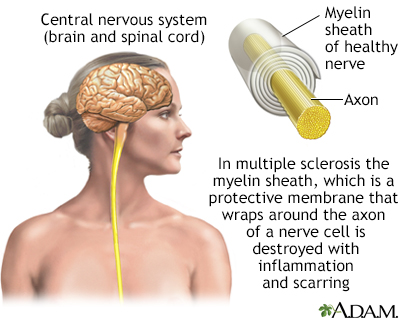Weakness
Lack of strength; Muscle weakness
Weakness is reduced strength in one or more muscles.
Images

I Would Like to Learn About:
Causes
Weakness may be all over the body or in only one area. Weakness is more noticeable when it is in one area. Weakness in one area may occur:
- After a stroke
- After injury to a nerve
- During a flare-up of multiple sclerosis (MS)
You may feel weak but have no real loss of strength. This is called subjective weakness. It may be due to an infection such as the flu. Or, you may have a loss of strength that can be noted on a physical exam. This is called objective weakness.
Weakness may be caused by diseases or conditions affecting many different body systems, such as the following:
METABOLIC
- Adrenal glands not producing enough hormones (Addison disease)
- Parathyroid glands producing too much parathyroid hormone (hyperparathyroidism)
- Low blood level of sodium or potassium
- Overactive thyroid (thyrotoxicosis)
BRAIN/NERVOUS SYSTEM (NEUROLOGIC)
- Disease of the nerve cells in the brain and spinal cord (amyotrophic lateral sclerosis also called ALS)
- Weakness of the muscles of the face (Bell palsy)
- Group of disorders involving brain and nervous system functions (cerebral palsy)
- Nerve inflammation causing muscle weakness (Guillain-Barré syndrome)
- Multiple sclerosis
- Pinched nerve (for example, caused by a slipped disk in the spine)
- Stroke
MUSCLE DISEASES
- Inherited disorder that involves slowly worsening muscle weakness of the legs and pelvis (Becker or other types of muscular dystrophy)
- Muscle disease that involves inflammation and a skin rash (dermatomyositis)
- Group of inherited disorders that cause muscle weakness and loss of muscle tissue (muscular dystrophy)
POISONING
- Botulism
- Poisoning (insecticides, nerve gas)
- Shellfish poisoning
OTHER
- Not enough healthy red blood cells (anemia)
- Disorder of the muscles and nerves that control them (myasthenia gravis)
- Polio
- Cancer
Home Care
Follow the treatment your health care provider recommends to treat the cause of the weakness.
When to Contact a Medical Professional
Contact your provider if you have:
- Sudden weakness, especially if it is in one area and does not occur with other symptoms, such as fever
- Sudden weakness after being ill with a virus
- Weakness that does not go away and has no cause you can explain
- Weakness in one area of the body
What to Expect at Your Office Visit
Your provider will do a physical exam. Your provider will also ask you about your weakness, such as when it began, how long it has lasted, and whether you have it all the time or only at certain times. You may also be asked about medicines you take or if you have been ill recently.
Your provider may pay close attention to your heart, lungs, and thyroid gland. The exam will focus on the nerves and muscles if the weakness is only in one area.
You may have blood or urine tests. Imaging tests such as x-ray or ultrasound, or MRI may also be ordered.
Related Information
MononucleosisFlu
Stroke
Multiple sclerosis
Peripheral
References
Eyre AJ. Weakness. In: Walls RM, ed. Rosen's Emergency Medicine: Concepts and Clinical Practice. 10th ed. Philadelphia, PA: Elsevier; 2023:chap 9.
Fearon C, Murray B, Mitsumoto H. Disorders of upper and lower motor neurons. In: Jankovic J, Mazziotta JC, Pomeroy SL, Newman NJ, eds. Bradley and Daroff's Neurology in Clinical Practice. 8th ed. Philadelphia, PA: Elsevier; 2022:chap 97.
Selcen D. Muscle diseases. In: Goldman L, Cooney KA, eds. Goldman-Cecil Medicine. 27th ed. Philadelphia, PA: Elsevier; 2024:chap 389.
BACK TO TOPReview Date: 7/23/2024
Reviewed By: Linda J. Vorvick, MD, Clinical Professor, Department of Family Medicine, UW Medicine, School of Medicine, University of Washington, Seattle, WA. Also reviewed by David C. Dugdale, MD, Medical Director, Brenda Conaway, Editorial Director, and the A.D.A.M. Editorial team.

Health Content Provider
06/01/2025
|
A.D.A.M., Inc. is accredited by URAC, for Health Content Provider (www.urac.org). URAC's accreditation program is an independent audit to verify that A.D.A.M. follows rigorous standards of quality and accountability. A.D.A.M. is among the first to achieve this important distinction for online health information and services. Learn more about A.D.A.M.'s editorial policy, editorial process and privacy policy. A.D.A.M. is also a founding member of Hi-Ethics. This site complied with the HONcode standard for trustworthy health information from 1995 to 2022, after which HON (Health On the Net, a not-for-profit organization that promoted transparent and reliable health information online) was discontinued. |
The information provided herein should not be used during any medical emergency or for the diagnosis or treatment of any medical condition. A licensed medical professional should be consulted for diagnosis and treatment of any and all medical conditions. Links to other sites are provided for information only -- they do not constitute endorsements of those other sites. © 1997- 2025 A.D.A.M., a business unit of Ebix, Inc. Any duplication or distribution of the information contained herein is strictly prohibited.
